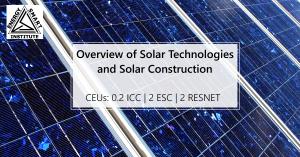New Overview of Solar Technologies Course Offered Now at EnergySmart Institute
New Overview of Solar Technologies and Solar Construction online, on-demand course now at EnergySmart Institute covering passive and active solar systems.
This quick but comprehensive course available from EnergySmart Institute includes:
How solar photovoltaic (PV) collectors are manufactured, the types of PV collectors available, and their efficiencies.
The difference between passive and active solar systems and an examination of their components.
How to size and determine the cost of a solar electric (PV) system.
How to calculate the federal tax credit incentives for residential renewable energy systems.
How to find additional rebates, incentives, funding, and other programs for residential renewable energy systems.
The sun provides free heat and light energy to us every day. Homeowners of new and existing homes are adding Solar Photovoltaic (PV) panels to their roofs and yards to take advantage of the sunlight to generate electricity. But some people just don’t like the look of a solar panel, or they are worried about the cost, maintenance, or reliability of the systems. However, there is much, much more to solar homes than panels on a roof.
Homes can be built to utilize passive solar energy in which the south side of the home is constructed as a collector that looks like a window or is transformed into a beautiful sunroom that captures the heat of the sun to warm the rest of the structure. It is more than just putting glass on the south side, however, there is quite a bit of planning and engineering that must be done to ensure the home does not overheat in the summer or lose too much heat in the winter. The heat is stored throughout the day in mass walls, or floors, or materials such as water or phase change salts. Then the heat is released as needed to the rest of the home. Existing homes can also be retrofitted with a passive solar wall or room as well. These systems can be changed from passive to active with the addition of fans or pumps that can themselves be powered by solar energy.
There are also systems that generate hot air or hot water directly from the sun without the use of solar electricity. Hot water solar panels can help provide hot water for radiant floor systems which are an extremely comfortable type of winter heating. These systems can also provide domestic hot water for cooking, bathing, and cleaning. Hot air panels can help provide heat directly to rooms that may not have a connection to the central heating system.
There are many varied and creative ways to include or add solar in a home. These methods can be mixed and matched as well. Solar is an energy solution available with a newly constructed or existing homes.
Other online, on-demand courses are available from EnergySmart Institute that can be taken anytime, night or day. Information about these courses can be found in the course catalog.
Ken Riead
Hathmore Technologies, LLC
+ + + +1 816-224-5550
Hathmore@Hathmore.com
Visit us on social media:
Facebook
Twitter
LinkedIn
Legal Disclaimer:
EIN Presswire provides this news content "as is" without warranty of any kind. We do not accept any responsibility or liability for the accuracy, content, images, videos, licenses, completeness, legality, or reliability of the information contained in this article. If you have any complaints or copyright issues related to this article, kindly contact the author above.



